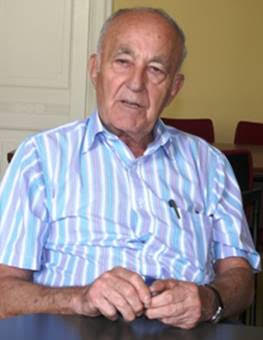
THE VOICE OF INTERNATIONAL LITHUANIA
|
VilNews has its own Google archive! Type a word in the above search box to find any article.
You can also follow us on Facebook. We have two different pages. Click to open and join.
|
Author Archive
- Posted by - (0) Comment
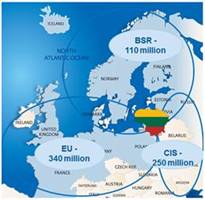
Lucintel estimates moderate growth for Lithuanian economy through 2018
The economy of Lithuania is expected to reach $57.3 billion by 2018. Economic growth of the country declined in the wake of economic crisis, but recovered impressively due to factors such as government stimulus packages and export growth. Slow growth rate was mainly caused by service sectors as construction, real estate, and financial intermediaries witnessing low productivity against increasing labor costs.
Lithuania is lagging behind Europe’s leading economies in terms of economy size and per capita income.
The study reveals that Lithuania is extremely dependent on trade with other European countries. Hence, change in the external demand may affect the economic situation.
Secondly, the population in Lithuania has been constantly decreasing over the last decade, as young people are emigrating to other countries for jobs and better livelihoods.
Read more...
- Bookmark :
- Digg
- del.icio.us
- Stumbleupon
- Redit it
- Posted by - (0) Comment
The land I lead you to
is Lithuania
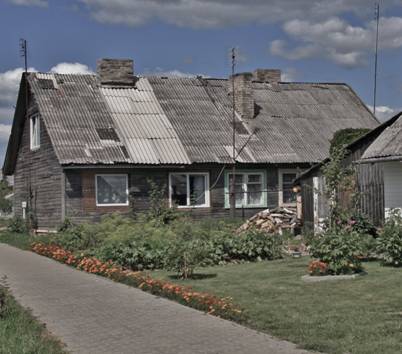
SMALL IS THIS LAND,
But great is its truths. To be. To survive. To testify by itself to the abundance and variety of the world’s nations, to the value of man’s life in freedom in his homeland.
PAINFUL IS THIS LAND,
Each blade of grass here sprouts from a drop of blood or a tear.
TOILFUL IS THIS LAND,
In the sandy soil of a hillock it grows both grain and graves marked with crosses.
BRAVE IS THIS LAND,
It went from uprising to uprising, from exile to exile, from deportation to deportation. A great number of its people were laid to rest in the permafrost of Siberia, some of their bones were flown back to their native soil, the survivors lost their health in slave labour, but returned home.
BEAUTIFUL IS THIS LAND,
Over each hillock, over each forest and over each lake it looks the same and different. It is just like our folk song: Though over the Nemunas river it seems to be sung in a different manner, it is nevertheless filled with the same longing and poignant emotion.
Justinas Marcinkevičius
- Bookmark :
- Digg
- del.icio.us
- Stumbleupon
- Redit it
- Posted by - (1) Comment
Justinas Marcinkevičius
(1930-2011)
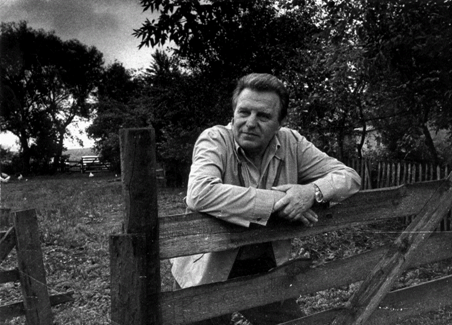
Justin Marcinkevičius Važatkiemio in his native village in 1986.
Photo: Romuald Rakausko.
Marcinkevičius was born in 1930 in Važatkiemis, Prienai district. In 1954 he graduated from Vilnius University History and Philology faculty with a degree in Lithuanian language and Literature. He joined the Communist party in 1957. He worked for a number of years as vice-chairman of the board of the official Union of Lithuanian Writers. He died in Vilnius on the 16th of February 2011.
Having grown up during the post-war period, Marcinkevičius evokes in his poetry a romanticized version of childhood spent in the Lithuanian countryside, of first love, of man's relationship with nature. In his poetry specific and solid peasant thinking is combined with a mind seeking to draw broad general conclusions, and the tradition of Lithuanian poetry singing the Earth's praises with contemporary modes of poetic thought. As a poet, he has sought to grasp the essence of national experience and give it fresh artistic expression. In his lyrical verse Marcinkevičius strives to comprehend the real meaning of what is going on inside man and society and moves the reader with his ardent lyrical confessions.
For most his life Justinas Marcinkevičius lived and wrote during the complex times of Soviet totalitarianism. He defended the cultural self-awareness of his nation. The poet brought back humanistic idea in describing a man, continued on the romantic and lyric poetry tradition, valued the aesthetic side of literature, as opposed to the heroic and propagandistic style of socialist realism. Marcinkevičius wrote poems in a romantic and modern style. Justinas Marcinkevičius is regarded as one of the most prominent members of Sąjūdis.
- Bookmark :
- Digg
- del.icio.us
- Stumbleupon
- Redit it
- Posted by - (0) Comment
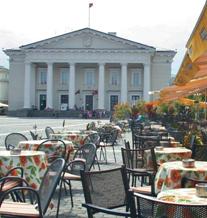
The world is about to
discover Lithuania!
Until recently, Vilnius was often called Europe's best kept secret. Very few knew that here lies one of the world's best-preserved cultural treasures, namely Eastern Europe’s largest and most attractive old town. Few knew that Vilnius is considered the world's most Italian city outside Italy and the world’ most Baroque city north of the Alps. This is now changing rapidly. The world population has become aware of both the city and the country and the number of travelers here is the sharp increase.
Read more...
__________________________

They were very surprised at the beauty of Vilnius, and the other places we visited. Everything they saw and experienced there was positive, and, now, five years later, they still talk about the wonderful experience they had there. Our tour was inexpensive, the hotels first class, the food wonderful, the beer out of this world, and the variety of other drinks was simply world class. I will never forget this trip, as my friends also will not. I would highly recommend Lithuania as a must see for any traveler.
Bernard Terway
- Bookmark :
- Digg
- del.icio.us
- Stumbleupon
- Redit it
- Posted by - (0) Comment

Without immigration policy, Lithuania will no longer be of interest for people who want to live here
Unless Lithuania adopts a sensible immigration policy, it is heading towards a demographic disaster – in 10 or 20 years, it will be a country of old men.
Canadian economist Arthur DeFehr, who has a business in Lithuania, offers the experience of Manitoba province in his native Canada as an example to follow. When it faced depopulation, the prairie province started importing foreigners it needed to revive the economy. The results more than met expectations – unemployment started shrinking and remained below the national average even during the downturn.
DeFehr, who has a degree from Harvard School of Economics and a wealth of international experience, knows what he is talking about. He was a godfather of the initiative aimed at attracting immigration to Manitoba. Over a decade ago, he became a member of the Trilateral Commission, has been in the World Economics Forum for many years, and has been developing a furniture business for almost five decades.
“If you're concerned about depopulation, you must think what to do,” DeFehr tells 15min. “People are moving to the city, so maybe Vilnius could keep its population. But if people continue to emigrate, both Vilnius and Kaunas will start shrinking. Social problems will surface – nothing new happening, universities shrinking... A country that has lost almost one third of its population over twenty years is facing a disaster in another 10 or 20 years. Lithuania will no longer be interesting enough for people to want to live here, it will become a place for pensioners.”
Read more…
- Bookmark :
- Digg
- del.icio.us
- Stumbleupon
- Redit it
The world is about to discover Lithuania!
- Posted by - (3) Comment
Until recently, Vilnius was often called Europe's best kept secret. Very few knew that here lies one of the world's best-preserved cultural treasures, namely Eastern Europe’s largest and most attractive old town. Few knew that Vilnius is considered the world's most Italian city outside Italy and the world’ most Baroque city north of the Alps. This is now changing rapidly. The world population has become aware of both the city and the country and the number of travelers here is the sharp increase.
Vilnius is the city Lonely Planet colourfully calls "eccentric and soulful," and one that offers the best overall hotel prices in all of Europe. According to Hotels.com's Hotel Price Index, Vilnius in Lithuania has an average per-night hotel price of $80, putting accommodations costs within reach of budget travelers. Sweeten the pot with a favorable exchange rate, quirky attractions, and Eastern Europe's largest old town, and you've got an intriguing and affordable destination.
Here are some recent articles:
| Vilnius – Baltic beauty |
|
| Vilnius: The cleanest air in Europe |
|
 |
Lithuania among “The World’s Ten Best Ethical Destinations – 2013” |
 |
Vilnius is one of Europe’s most affordable cities for 2013 |
- Bookmark :
- Digg
- del.icio.us
- Stumbleupon
- Redit it
- Posted by - (0) Comment
Rescuing a Photo Prince
From Obscurity
By JULIE TURKEWITZ, NEW YORK TIMES
Tanya Aldag slips into a closet-size room in her home in suburban Maryland. The door clicks shut. Here, surrounded by thousands of black and white prints, she goes tumbling back to Soviet-era Lithuania.
“It’s like you’re going deep into the water,” she said. “It can be hard to go there.”
Ms. Aldag, 64, is the widow of Vitas Luckus, once a prince — perhaps even a king — of the Soviet photography scene. From the 1960s to the mid-1980s, he traveled throughout the Soviet bloc, capturing peasants, performers, partiers and policemen, as well as a generation of grippingly attractive young artists. He scurried across sloping rooftops (Slide 15), camera swinging from his neck. He worked obsessively, with little care for what others thought. The secret police were a constant presence in his life, burgling his home and beating him in bathrooms and cafes.
- Bookmark :
- Digg
- del.icio.us
- Stumbleupon
- Redit it
- Posted by - (0) Comment

Lithuania leads the EU in industrial growth
In January 2013 compared with January 2012, industrial production decreased by 1.3% in the euro area (EA17) and by 1.7% in the EU27, according to estimates released by Eurostat, the statistical office of the European Union. Based on these estimates, Lithuania is among the countries with the highest growth of industrial production in the EU.
Among those countries for which data are available, industrial production fell in eleven and rose in seven EU member states. The largest decreases were registered in Sweden (-5.9%), Finland (-5.4%), Greece and Spain (-5%), with the highest increases in Bulgaria and Lithuania (8% each) as well as Estonia (5.5%).
In January 2013 compared with January 2012, production of durable consumer goods fell by 5.5% in the euro area and by 4.3% in the EU27. Intermediate goods production dropped by 3.1% and 3.4%, respectively. Capital goods production decreased by 2.6% in both zones. Production of energy increased by 0.9% in the euro area and remained stable in the EU27. Production of non-durable consumer goods rose by 3.1% and 2.2%, respectively.
- Bookmark :
- Digg
- del.icio.us
- Stumbleupon
- Redit it
- Posted by - (0) Comment
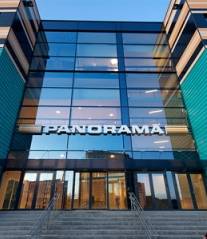
Estonians to develop four office buildings in Vilnius for EUR 44m
Estonian E.L.L. Real Estate property development and management group that is majority-owned by Estonian businessman Toomas Annus plans to develop four office centres in Vilnius with a total leasable area of 44,000 sq.m at a cost of EUR 44 million euros, writes Äripäev with reference to news2biz LITHUANIA.
First in line is the smallest project of the four, a 4,300 sq.m, 7-storey, class A building very close to Vilnius' central business district. E.L.L. has already hired Lithuanian Baltic Engineers consultancy to design the technical project and find architects.
The building will be located next to a residential multi-unit house developed by E.L.L. earlier, and overlooking E.L.L.'s biggest project in Lithuania to date, the 65,000 sq.m Panorama shopping and business centre.
Read more...
- Bookmark :
- Digg
- del.icio.us
- Stumbleupon
- Redit it
- Posted by - (0) Comment

Lithuania’s best future lies in a Nordic union
“Russia can turn the lights out on Lithuania and the other two Baltic states any time it pleases. And they can't turn them back on without Russia’s permission. Not only does this small, central European nation, as well as its neighbors Latvia and Estonia, not have access to the Russian owned-switch, but, to a large extent, it also depends on energy supplies from Russia to power its electricity generating plants; power that is needed for energy and economic independence. Lithuania as well as the other Baltic countries, being poor in energy resources, are facing a tough future and are seeking solutions.”
This was what Dr. Stan Backaitis wrote here in VilNews in 2011. We have also published articles stating that Lithuania’s dependence on Russia, to a certain degree also EU, should be reduced. We have stated that the neighbours to the north in many cases would be much more attractive partners.
__________________________
I heartily agree

Bravo! I heartily agree. In pondering the often sad history of Lithuania I seem to always come to the conclusion that a small country like Lithuania needs to come to some close relationship with some combination of neighbors in order to gain long term stability and security. The Grand Duchy was probably the best example.
Today, association with NATO and the EU has gone far to secure a degree of that security and prosperity but with the various issues in Europe and even questionable engagement of the US, something deeper must be developed.
Scandinavia seems to be, and in fact has evolved as a strengthening partner and role model which I think many Lithuanians probably accept.
Not to take away from other efforts and positive, even close, relations with other neighbors (Poland, even Russia), closeness with Scandinavia and emulation of its institutions would serve Lithuania well.
Rimantas Aukstuolis
- Bookmark :
- Digg
- del.icio.us
- Stumbleupon
- Redit it
- Posted by - (0) Comment

Soviet remnants
in Lithuania
The green Soviet
bridge in Vilnius
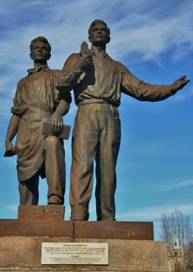
The Green Bridge sculpture "Industry and Construction (Pramonė ir statyba)" by Bronius Vyšniauskas and Napoleonas Petrulis. Photos: Aage Myhre.
Read more...
__________________________
Jurate Kutkus Burns As long as they are not glorifying one of the tyrants, these statues should stay.
__________________________
Justinas V. Daugmaudis I would not call these sculptures as "soviet remnants". Doing so simply shows that the person fails to understand the context. The sculptures are the authentic artifacts of the time not so long past, and they serve a concrete purpose -- to remind us that that this past was far from rosy (and that we do not want a repeat of it). One must never forget, lest one lives in a dream that is disconnected from (sometimes stark) reality.
Europe, in general, is different from the US. We like our reminders, and we like things old. We like those reminders even if they are not too pleasant.
__________________________
Julius van Cerniauskas "Europe, in general, is different from the US. We like our reminders, and we like things old. We like those reminders even if they are not too pleasant."
no we dont. I would like to see these 2 balvonai drown in Neris.
experts say that the statue badly needs repairs. i think it doesnt. it needs to start dropping in pieces just like USSR did. WHAT A SPECTACULAR PERFORMANCE WOULD THAT BE!!!
__________________________
Justinas V. Daugmaudis You don't understand that Vilnius is replete with the artifacts of the past generations. You dislike the USSR, but so do I; as much forcefully, in fact. Still, it is OUR history. We have persevered, whilst the USSR -- despite all of its might -- did not. Consider the sculptures as a token of sadistic glee, if you want.
__________________________
Julius van Cerniauskas
if Nazis erected a statue for Adolf during their short occupation of LT, should we have kept it too? lets return Lenin's statue to Lukiskiu aikste as well? why not? fact is.. this statue annoys many people. thats all. it should be moved to Grutas park where all history masochists can enjoy themselves to their hearts content. I believe Germans had a fair amount of "artifacts" from their Nazi era too. I guess that not many(if any) of them were left in public places.
__________________________
Justinas V. Daugmaudis Nothing could be more further from truth, my dear Julius. The German acceptance, and sometime embrace, of its monstrous past is seen as a sign of maturity by historians and academics. (Not so long ago record numbers of German television viewers tuned in to a domestically made documentary on the Holocaust, a programme unthinkable just a few years ago.)
Buildings used by the officers at the notorious female concentration camp of Ravensbruck -- where Anne Frank died along with as many as 92000 other female and child inmates including the British SOE agent Violette Szabo -- are being CONVERTED into a youth hostel and an educational institute. NOT DEMOLISHED! Eight of the 23 former SS guardhouses have been converted to cater for an estimated 13,000 visitors each year. This conversion project is one of the latest in which many of the Third Reich's most infamous sites have been transformed into tourism or leisure venues as Germany seeks to draw a line under its past. Germans themselves are queuing up for a glimpse of a time that has been buried beneath layers of guilt, uncertainty and shame.
I would agree that Hitler and his legacies will never beat Euro Disney as the holiday destination of choice. Still, there is a quiet but defineable determination within the German psyche to visit the places where the madness was spawned and to understand it.
Ravensbruck is but one Nazi site among many that has been or is about to be transformed for "educational tourism". After the war many buildings which represented the monstrosity of National Socialism were destroyed. The Allies had a dual motive for this: to erase the memory of Nazism and to prevent "shrines" developing in the future -- an idea that persisted for decades. Nowadays, this rampant post-war destruction is considered to be a "barbarian" -- albeit "understandable" -- act, as it was not known better at the time.
The Berghof, Hitler's mountain home in Bavaria, was destroyed in 1945 as was Spandau prison in the late 1980s after the last inmate, Hitler's deputy Rudolf Hess, died. In the past year, however, many other sites of importance in the Third Reich have become the magnets of educational tourism.
What you have to understand, my dear Julius, is that Nazi artifacts themselves are becoming public places. Not because there is any love left for Nazis, but simply because to remember means not to repeat.
Now, as for Hitler's statues -- they were removed. The same was done with Lenin's (and other so-called leaders') statues in Lithuania. The statues on the Green bridge are not even in the same category, for they do not enshrine any concrete person that would symbolize the oppressive regime.
Your suggestion to remove the statues on the Green bridge (along with other artifacts, no?) simply means that you want to cut out 50 years of occupation from the memory of people. An exceedingly shallow idea, because it's also the memory of our own people, of our own country. Besides, why do you feel so fixated on these statues? Why don't you
suggest to burn the books written during the reign of the regime? Why don't you suggest to bring down buildings? National Opera and Ballet Theater is a perfect example of -- then award winning -- soviet architecture, and it is much more visible than those aforementioned statues, too. Yet you keep silent about those other cultural artifacts. It is likely that the reason is simple -- you don't even think about them. (It is hard to think when you are simply parroting the same shallow categorical ideas that were spread by some not-too-clever journalists that don't even have any proper education. Big mouth leaves little place for brain.)
Summa summarum, when you are blind to many other (too subtle?) cultural artifacts of the regime, then if those statues on the Green bridge make you think and feel strongly about the USSR, this means that the statues serve their purpose.
__________________________
Viktorija Ruškulienė Art often represents not only the regime (in this particular case - Soviet occupation), but also culture, fashion, historical moment, influences of social/environmental/political ideas, mentality of that time. Removing the statue will not erase the history, and there is no need to do that. I prefer this peace with two workers much better to the peace of early independence "Vamzdis…
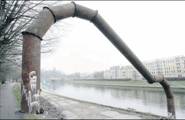
__________________________
Timotiejus Sevelis KNOCK IT DOWN!!
__________________________
Siga Eidukonis It's ART!!! and I always thought it was the old soviet heating & water supply system... Aciu, Viktorija Ruškulienė...good info!
__________________________
Timotiejus Sevelis forget the shitty past, move on, and create the bright future that was intended!!
- Bookmark :
- Digg
- del.icio.us
- Stumbleupon
- Redit it
Author Ellen Cassedy in her ancestral homeland
- Posted by - (0) Comment
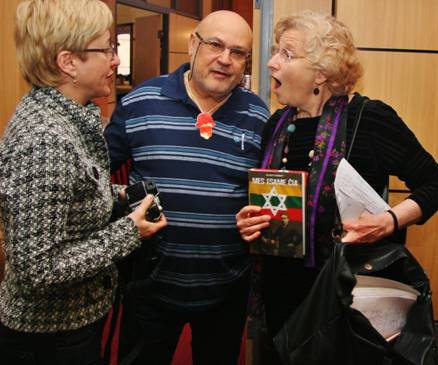
The U.S. author of the book "We are here" (Mes esame čia), Ellen Cassedy (right), was in Lithuania last month. Here in eager discussion about Jewish life in Lithuania before the Holocaust and now today.
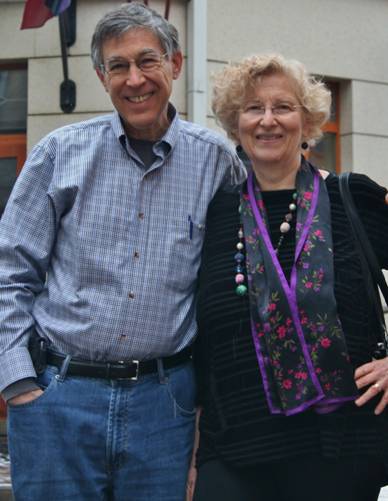
Ellen Cassedy in Vilnius last month, with her husband Jeff.
Read her own report from the visit HERE
- Bookmark :
- Digg
- del.icio.us
- Stumbleupon
- Redit it
Author Ellen Cassedy in her ancestral homeland
- Posted by - (7) Comment

The
U.S. author of the book "We are here" (Mes esame čia), Ellen Cassedy
(right), was in Lithuania last month. Here in eager discussion about Jewish
life in Lithuania before the Holocaust and now today.
|
Below: Ellen Cassedy’s report from her visit to Lithuania |
|
- Bookmark :
- Digg
- del.icio.us
- Stumbleupon
- Redit it
- Posted by - (0) Comment
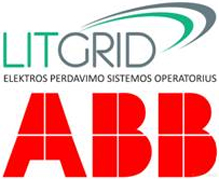
Litgrid and ABB sign important agreement on LitPol Link
The newsletter Energy Update, published by the Lithuanian transmission system operator Litgrid, summarizes the latest developments in the Lithuanian electricity sector.
In this issue:
- Litgrid and ABB signed a historical agreement on the construction of the LitPol Link power interconnection facility;
- The plans of electricity network development lie in the hands of competent specialists;
- Litgrid Junior Professionals Programme – perfect start for a career in power engineering;
- Students prepare electric energy plans for the next three decades;
Read more...
- Bookmark :
- Digg
- del.icio.us
- Stumbleupon
- Redit it
- Posted by - (0) Comment

The green Soviet bridge
in Vilnius
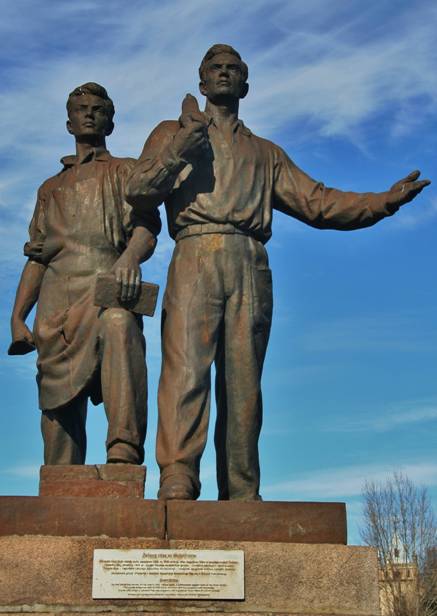
The Green Bridge sculpture "Industry and Construction (Pramonė ir statyba)" by Bronius Vyšniauskas and Napoleonas Petrulis.
Photos: Aage Myhre.
The Green Bridge (Lithuanian: Žaliasis tiltas) is a bridge over the Neris River in Vilnius, Lithuania. It is the oldest bridge in the city and connects city centre with the so-called right river bank and the Kalvariju g that leads to several of the city’s Soviet suburbs north of the city centre.
The first bridge is known from 1536. It stood closer to the present-day Mindaugas Bridge. It was a wooden covered bridge with brick and stone piers. It had a second floor with apartments for toll collectors. Because its builder Ulryk Hozjusz wanted to recoup the cost by collecting tolls, Grand Duke Sigismund I granted him a privilege prohibiting others to build any other bridges between Kernavė and Bistrica or to offer other crossing services between Verkiai and Paneriai. The bridge was burned by retreating Lithuanian Army after the Battle of Vilnius (1655).
- Bookmark :
- Digg
- del.icio.us
- Stumbleupon
- Redit it
- Posted by - (1) Comment

The green Soviet bridge in Vilnius

The Green Bridge sculpture "Industry and Construction (Pramonė ir statyba)"
by Bronius Vyšniauskas and Napoleonas Petrulis.
Photos: Aage Myhre.
The Green Bridge (Lithuanian: Žaliasis tiltas) is a bridge over the Neris River in Vilnius, Lithuania. It is the oldest bridge in the city and connects city centre with the so-called right river bank and the Kalvariju g that leads to several of the city’s Soviet suburbs north of the city centre.
The first bridge is known from 1536. It stood closer to the present-day Mindaugas Bridge. It was a wooden covered bridge with brick and stone piers. It had a second floor with apartments for toll collectors. Because its builder Ulryk Hozjusz wanted to recoup the cost by collecting tolls, Grand Duke Sigismund I granted him a privilege prohibiting others to build any other bridges between Kernavė and Bistrica or to offer other crossing services between Verkiai and Paneriai. The bridge was burned by retreating Lithuanian Army after the Battle of Vilnius (1655).
A new project was prepared in 1673, which envisioned a span of 73 metres (240 ft) between piers—the longest known span at the time. However, an early spring and ice jam destroyed the piers. Therefore the old piers from the first were reused and the second bridge was complete in 1679. In 1739 another wooden bridge was erected and painted green. Since then it is known as the Green Bridge. In 1789 a new project of a brick bridge was prepared by Laurynas Gucevičius, but the builders selected another proposal. The construction was supervised by Marcin Knackfus. The project was not successful as the bridge burned in 1791. It was rebuilt according to a project by Michael Schulz in 1805, but burned again on orders from Michael Andreas Barclay de Tolly during the French invasion of Russia of 1812.
The bridge was rebuilt in 1827–1829. A steel bridge was designed by Nikolai Belelyubsky and completed in 1894. It survived World War I, but was blown up by the Wehrmacht in 1944. The present-day bridge was completed in 1952 and named after Soviet General Ivan Chernyakhovsky. After the declaration of independence in 1990, the bridge regained its historical name.

The bridge features four sets of sculptures—prominent examples of Soviet realism. They all feature two people, representing social classes idealized by the Soviet authorities (soldiers, workers, farmers, students). Three sculptures are 3.2 metres (10 ft) in height (including the pedestal); the soldiers reach 4 metres (13 ft) due to the raised flag.

The sculpture "Agriculture (Žemės ūkis)" by Bernardas Bučas and Petras Vaivada.
- Bookmark :
- Digg
- del.icio.us
- Stumbleupon
- Redit it
VilNews e-magazine is published in Vilnius, Lithuania. Editor-in-Chief: Mr. Aage Myhre. Inquires to the editors: editor@VilNews.com.
Code of Ethics: See Section 2 – about VilNews. VilNews is not responsible for content on external links/web pages.
HOW TO ADVERTISE IN VILNEWS.
All content is copyrighted © 2011. UAB ‘VilNews’.

 Click on the buttons to open and read each of VilNews' 18 sub-sections
Click on the buttons to open and read each of VilNews' 18 sub-sections 






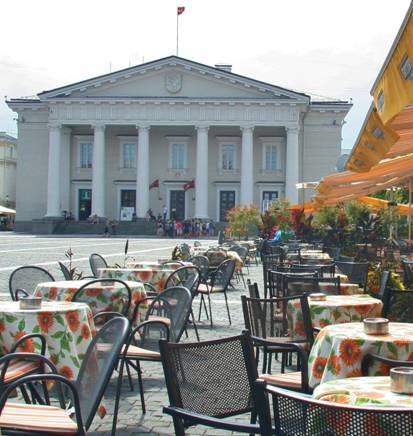











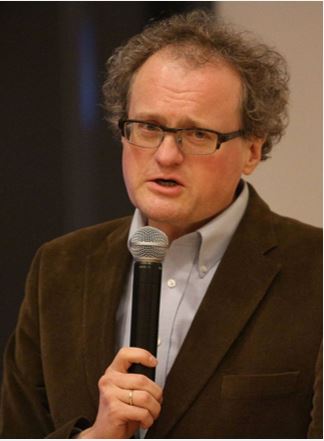

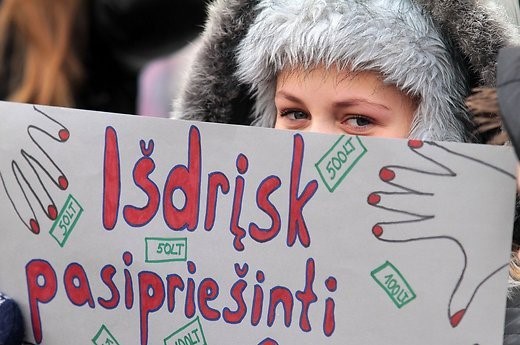


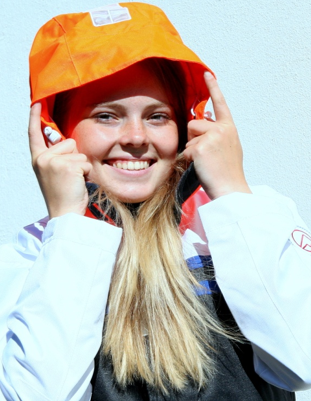
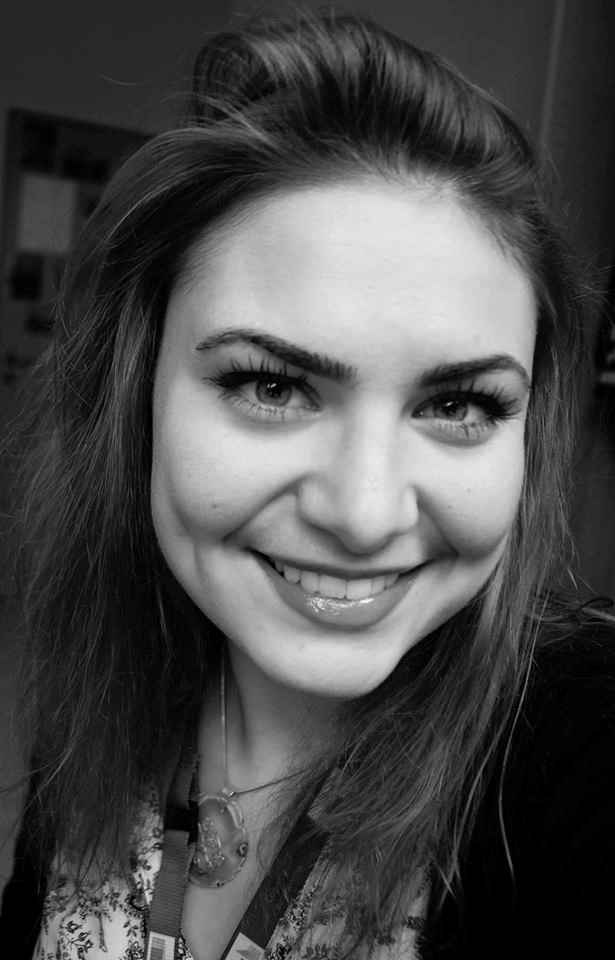

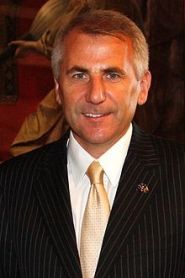
.jpg)
